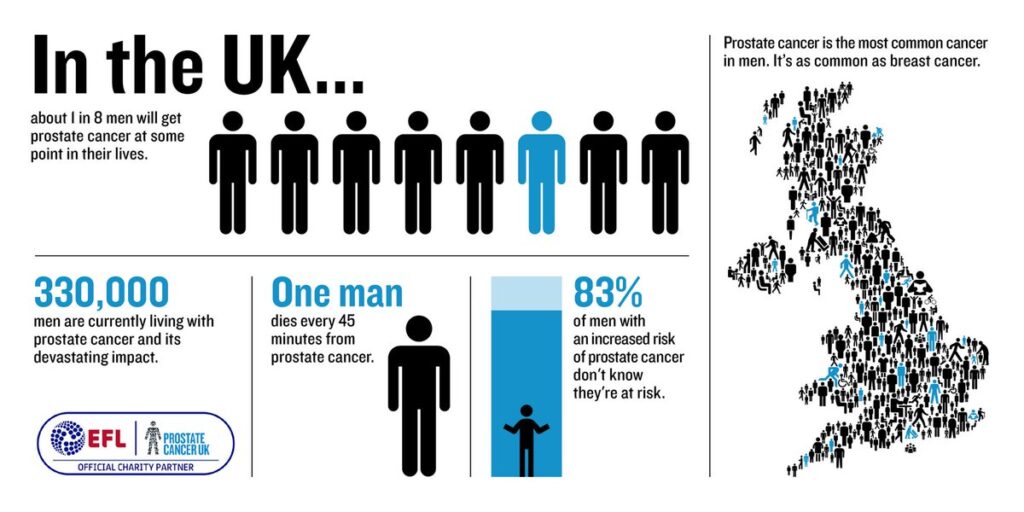
The truth about prostate cancer – the most common cancer in men in the UK
If you’re worried about changes to your urinating habits, or you want to know how to check for signs of prostate cancer, this expert guide should hopefully help
W e’ve previously published a guide on how to check your balls for signs of testicular cancer but there’s a much more common, harder to detect cancer that is affecting nearly 50,000 men in the UK every year – prostate cancer.
World Cancer Day took place on 4 February 2022 and as part of the World Health Organisation’s “Closing the Care Gap” campaign, BXTA – a provider and distributor of a form of prostate cancer treatment called Brachytherapy – is calling on men, their loved ones and friends to raise awareness of the disease, and its symptoms.
Prostate cancer UK
In the UK, about 1 in 8 men will get prostate cancer at some point in their lives and this rises to 1 in 4 if you’re black. This risk further increases if you’re aged 50 and over and you have a family history of prostate cancer.
In fact, one of the main risk factors for prostate cancer is having a family history of it and Prostate Cancer UK says you are two-and-a-half times more likely to get prostate cancer if your father or brother has had it.
The prostate is a small gland in the pelvis that forms is part of the male reproductive system. It’s found between the penis and the bladder and is normally the size of a walnut. It is in the prostate where the thick white fluid that makes up a large part of semen is produced.
Prostate cancer can cause the prostate to increase in size, and this can have a knock-on effect on your urinating habits. It can also cause erectile dysfunction.
 Prostate Cancer UK
Prostate Cancer UK
According to the NHS, the symptoms of prostate cancer tend not to appear until the prostate is “large enough to affect the tube that carries urine from the bladder out of the penis,” known as the urethra. At this stage, you might feel the urge to pee more often. You may find yourself straining and pushing while urinating, and your bladder may feel full, or not empty, all the time.
That’s not to say these symptoms are always a sign of prostate cancer, they can also be caused by something called prostate enlargement, or a urine infection.
If you think you might be at risk, you can check your symptoms at the Prostate Cancer UK website, via its Risk Checker. This online quiz takes 30 seconds and asks you questions about your age, your family history and your ethnicity.
Signs and symptoms of prostate cancer
Before we explain how doctors test for prostate cancer, we wanted to explain what to look out for and how to determine your risk.
SIGNS AND SYMPTOMS OF PROSTATE CANCER
Prostate cancer symptoms are hard to detect because they often don’t appear until the prostate is a certain size.
These symptoms include:
- Needing to pee more
- Straining while peeing
- Erectile dysfunction
- Bladder feeling full
Source: NHS
According to the NHS, prostate cancer symptoms typically cause problems with urinating as well as getting an erection.
It’s easier and more effective to treat when caught early but because the symptoms tend not to make themselves known until further down the line, this can cause complications.
This is why it’s critical that men understand the risk and seek guidance if they think anything is wrong, no matter how small or seemingly insignificant.
“A lot of the time, many men go undiagnosed, particularly within the early stages of prostate cancer as they don’t experience signs or symptoms, which is why raising awareness of the possible symptoms is vital,” said BXTA managing director, Saheed Rashid.
“These include a weak flow when urinating, loss of bladder control, erectile dysfunction and pain in the back, hips, ribs or pelvis. Men who have any of these symptoms must be encouraged to go to their GP and initially get a PSA test.”
Below we explain more about what a PSA test is and how your GP will go about determining if there is something to worry about.
Prostate cancer tests and treatments: PSA to Brachytherapy
 Prostate Cancer UK
Prostate Cancer UK
There is not a one-size-fits-all test when it comes to finding out if you have prostate cancer or not, but there are a few things your GP will check to see if there is at least a problem that need single test to diagnose prostate cancer. There are a few tests that your GP can do to find out if you have a prostate problem, though.
These include a urine test, to check for a urine infection, a rectal examination, and a PSA, or “prostate-specific antigen” blood test.
If any of these tests suggest you have a problem with your prostate, or they can’t rule out other causes such as a urine infection, you may be referred to the hospital or to a specialist. This specialist will take another look at your PSA results, and may arrange a follow-up. They may also give you an MRI scan, a CT scan, and/or a prostate biopsy.
If it is discovered you have prostate cancer, there is a number of treatments that can be considered. The type of treatment will depend on how far the cancer has spread, the size of the cancer, and other factors. However, the main treatments typically include:
- surgery (radical prostatectomy)
- external beam radiotherapy
- brachytherapy
“If caught early, prostate cancer can be easy to treat, with effective and minimally invasive pathways available to patients,” continues Rashid. “There are many treatment options available, especially when it is diagnosed in the less aggressive stages, including Low Dose Rate (LDR) brachytherapy, which is a form of radiation that delivers treatment to a targeted area using small radioactive seeds, which are inserted permanently into the prostate gland.
“The procedure is quick, with many patients being sent home the next day. Additionally, the treatment has a low complication rate due to being minimally invasive, with significant quality of life benefits over alternative options, such as radical prostatectomy, or removal of the prostate. Again, knowing what your diagnosis is at an early stage allows for treatment to be planned well in advance, in the assurance that personal health and safety and NHS resources are paramount.”
MORE LIKE THIS

Subscribe to the MBman newsletter to stay updated
Feature picture credit: Image by Darko Djurin from Pixabay













